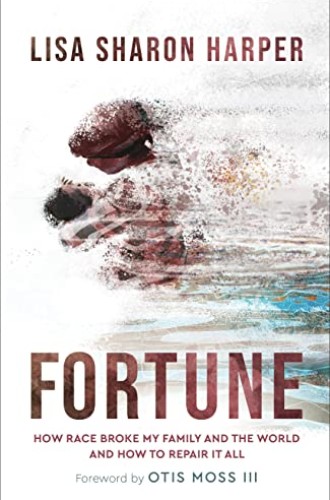Lisa Sharon Harper’s memoir of the legacy of slavery
Fortune gives a wrenching account of intergenerational trauma and its costs.
When Lisa Sharon Harper embarked on a pilgrimage to the Eastern Shore of Maryland, where her enslaved ancestors arrived from West Africa in the 1680s, she had been researching her family tree for decades. This was no easy task when so many earlier generations had tried to forget the past.
Her quest to understand where and who she came from was made difficult by the reality of trauma, family separation, and the deprivation of basic human rights for enslaved people and their descendants. “Previous generations did not have the luxury of memory,” Harper says. Only White births, marriages, and deaths were reliably recorded by historians and census takers. Scant information gleaned from living relatives—a few names and places and hints of Cherokee or Chickasaw ancestry, including a beautiful beaded necklace she inherited from her grandfather—were the bread crumbs she followed.
Read our latest issue or browse back issues.
It wasn’t until Harper joined Ancestry.com in 2010 that she was able to confirm the existence of those who had seemed as myths to her, “like the Greeks spoke of Hermes and Dionysus,” traceable to a slave schedule listing the human property of a White man named Jonathan Lawrence. Black life and death were not worth recording, she emphasizes, except as property gained or lost.
With the help of genealogy websites and national archives, Harper was able to fill in the branches of her family tree and began to sketch the lost stories of her family. She tells some of those stories in Fortune. Many times during her research and writing, Harper says, she found herself weeping.
Fortune is a devastating book. Harper makes real the costs of intergenerational trauma still being paid by the descendants of enslaved people in this country. Like the 1619 Project, Harper’s book challenges received narratives of American history—but it does so with the wrenching specificity of memoir. In exposing the sources of the fractures in her own family line, Harper doesn’t just explain the genesis of the first racist laws that made life hell for previous generations of Americans; she shows us through painstaking re-creation how their invention and implementation are very much part of our ongoing story.
She begins in 1705, in a Maryland courtroom where the eponymous Fortune Game, Harper’s ancestor, awaits a verdict on her fate. Fortune is a mixed-race, 18-year-old woman born to an Ulster Scots mother, who had been brought to America as an indentured servant, and an enslaved father, who was likely kidnapped and sold into slavery in eastern Senegal. At the time of Fortune’s birth, a child’s slave or free status was determined by their mother’s status—a law that Harper points out allowed White slaveholders to increase their wealth by raping enslaved Black women with impunity.
In 1664, the Maryland General Assembly, anxious not to forego the free labor of a growing number of mixed-race children of White women, had decided that the children of marriage between a free White woman and an enslaved Black man would be enslaved for life, and all their descendants after them. The White woman would also become the property of the husband’s master until the time of the husband’s death. But by the time Fortune stood before the court in 1705, the General Assembly had back-tracked from enslaving white women and their mixed-race children. Instead, a 1692 law prohibited their enslavement, but mandated indenture. If the child, like Fortune, was born to unwed parents, she would serve the master for 31 years as an indentured servant.” Indenture was just as brutal as slavery,” Harper reminds us. It simply had an end date. The court sentenced Fortune to serve Mary Day until the age of 31.
The impact of the 1692 Maryland race law on Fortune’s life echoes for generations. No father is attributed to her daughters Perlina, Betty, and Sarah, but Harper concludes he was a White man based on the length of their indentured service—21 years each, the sentence for children of White men born to indentured mothers. If this free White man had chosen to marry Fortune, he too, under the law, would have been sentenced to indentured service for a total of seven years.
One begins to see the way states continually erected barriers to freedom and flourishing for Black and mixed-race families. While race laws in Maryland did not prevent the mixing of races at the time, says Harper,
they prevented many Black and mixed-race women from being protected by, provided for by, and committed to one man. They blocked Black and mixed-race children from knowing the shelter and full protection of parents for more than 250 years. Reverberations roll through the generations, taking up residence in our very bodies.
This is the story of just one law and its cascading impact on one family’s history. Harper goes on to tell story after story like this one, untangling the complicated legal structures that broke her family and carefully stitching their narratives back together.
There are multiple breathtaking moments when this story intersects with landmarks in American legal history. In one, the daughter of Richard and Mildred Loving, the interracial couple who in 1967 challenged Virginia’s 1662 race law in the Supreme Court in Loving v. Virginia, marries one of Fortune’s descendants.
Harper moves us through her personal history from the earliest records of colonial America to her own lifetime up to the election of Kamala Harris as vice president. It’s a joy to accompany her as she discovers her own story. It feels like holy work.
When I finished Fortune, I was overwhelmed by the feeling that I had been generously invited into the sacred space of an entire family’s collective memory. But I was also hungry for justice. When Harper turns, in the last third of the book, from the mending of personal fractures to the steps we might take to repair the ongoing damage of White supremacy and racism in America, her call to beloved community lands with even greater urgency because of the family story she has told.








